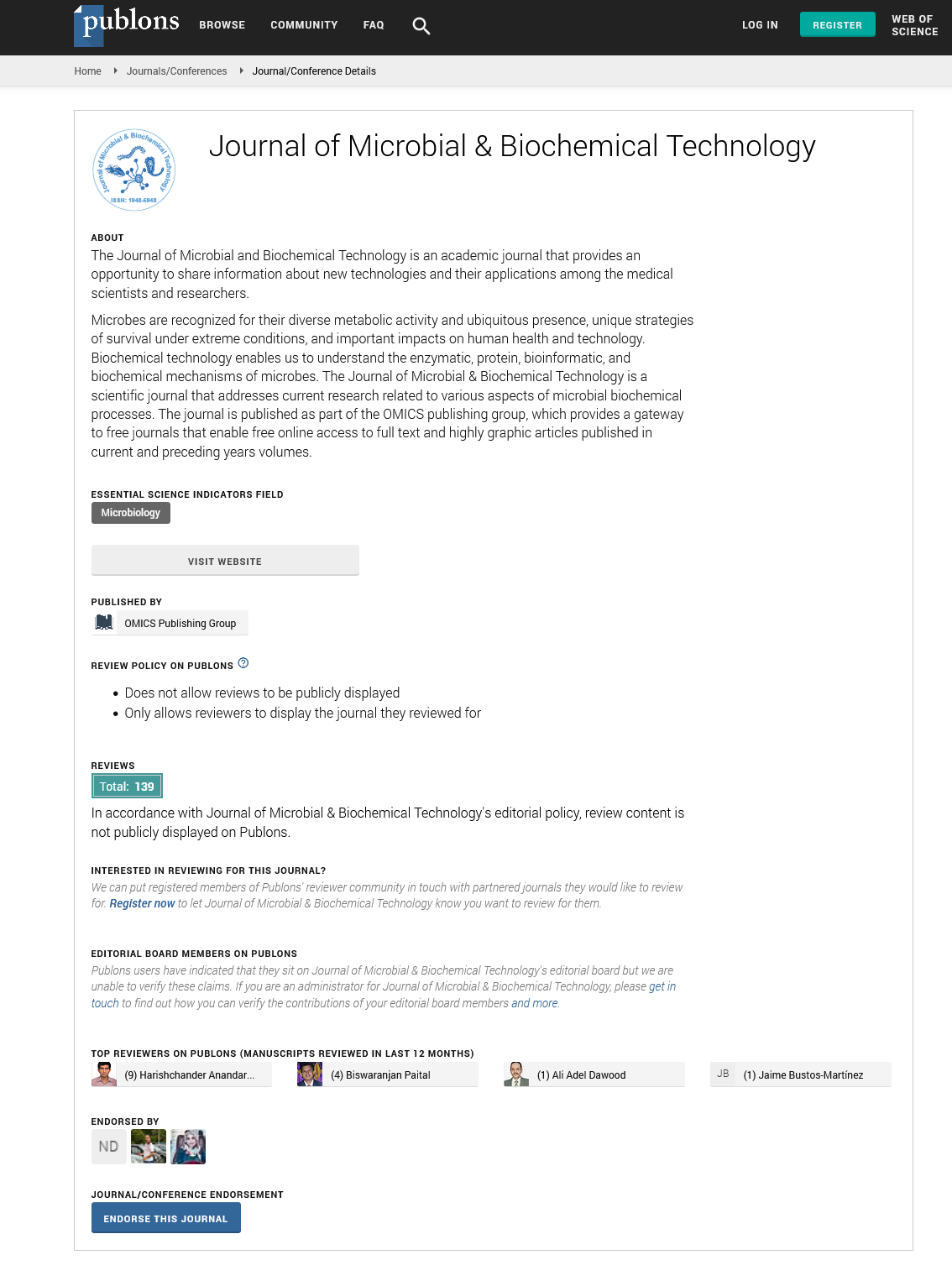Indexed In
- Academic Journals Database
- Genamics JournalSeek
- Academic Keys
- JournalTOCs
- China National Knowledge Infrastructure (CNKI)
- Scimago
- Access to Global Online Research in Agriculture (AGORA)
- Electronic Journals Library
- RefSeek
- Directory of Research Journal Indexing (DRJI)
- Hamdard University
- EBSCO A-Z
- OCLC- WorldCat
- SWB online catalog
- Virtual Library of Biology (vifabio)
- Publons
- MIAR
- University Grants Commission
- Geneva Foundation for Medical Education and Research
- Euro Pub
- Google Scholar
Useful Links
Share This Page
Journal Flyer

Open Access Journals
- Agri and Aquaculture
- Biochemistry
- Bioinformatics & Systems Biology
- Business & Management
- Chemistry
- Clinical Sciences
- Engineering
- Food & Nutrition
- General Science
- Genetics & Molecular Biology
- Immunology & Microbiology
- Medical Sciences
- Neuroscience & Psychology
- Nursing & Health Care
- Pharmaceutical Sciences
Biotechnological potential of the microflora associated with the brown alga Ascophyllum nodosum
World Congress and Expo on Applied Microbiology
August 18-20, 2015 Frankfurt, Germany
Marjolaine Martin, Renée Martin, Tristan Barbeyron, Daniel Portetelle, Gurvan Michel and Micheline Vandenbol
University of Leige, Belgium
Scientific Tracks Abstracts: J Microb Biochem Technol
Abstract:
Bacteria associated with algae are underexplored despite their huge biodiversity and the fact that they differ markedly from those living freely in seawater. These bacterial communities are known to represent great potential for the production of diverse bioactive compounds, such as specific glycoside hydrolases, as they interact in multiple complex ways with their host. Furthermore, enzymes from marine bacteria have original properties, like cold-adapted, halotolerant and highly stable, which are constantly searched out by bio-industries.The aim of our study was to identify bacteria, associated with the brown alga Ascophyllum nodosum, showing diverse polysaccharolytic activities. To isolate cultivable microorganisms, algal thalli of Ascophyllum nodosum were swabbed with sterile cotton tips and marine agar plates were inoculated. Three-hundred isolated bacteria were screened for agarase, kappa-and iota-carrageenase, and sulfatase activities on specific marine media. Thirty-two bacteria with polysaccharolyticactivitieswere isolated and a part of their 16S rDNA (8F-1492R) were amplified and sequenced. Twenty-seven were classified as Flavobacteria and five as Gamma proteobacteria. Putative new strains and species of Zobellia, Maribacter, Cellulophaga, Shewanella, Glaciecola, Pseudoalteromonas and Colwellia were identified by phylogenetic analysis. All those genera are well-known to colonize algal surface but only some of them are famousto degrade algal polysaccharides (Zobellia, Maribacter, Cellulophaga, and Pseudoalteromonas). However, all those novel bacterial strains/species showed multiple and diverse enzymatic activities (agarase, iota-and kappa-carrageenase, cellulase, beta-glucosidase, sulfatase and/ or amylase activities). Genomics libraries with their DNA were constructed in Escherichia coli and Bacillus subtilis and are screened to identify the genes coding for the observed enzymatic activities. Those novel glycoside hydrolases from unknown marine bacteria should have original and innovative properties with great biotechnological potential.
Biography :
Marjolaine Martin started her education at Gembloux Agro-Bio Tech (University of Liège) in 2005. She ended her studies in 2010, with a 4 months stay in Bolivia where she realized a part of her master thesis regarding the prevalence of the Bovine Viral Diarrhea Virus in bovine and lamas farm. After graduation, she was immediately hired to start a PhD as a research and teaching assistant at the Microbiology and Genomics Unit of her university. Begin 2012, she realized a 7 months stay at the Biological Station of Roscoff (Britanny, France). There, she worked on the microflora associated with brown and red algae and get to know to work with this new environment. She presented her results at the National Symposium on Applied Biological Sciences (NSABS18 in Ghent (Belgium)), where she received the best oral presentation in the “Human health and Biotechnology” session. She published a review in Applied Microbiology and Biotechnology dealing with the diversity and the biotechnological potential of those communities. A second paper followed quickly concerning the identification and purification of an interesting cold adapted and halotolerantendo-glucanase in the prestigious American review of Applied and Environmental Microbiology. She is now, ending her PhD while working on cultivable microorganisms associated with the brown alga Ascophyllumnodosum and their biotechnological potential.

